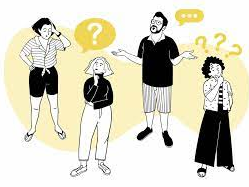If you are vigilant, you might have noticed that one day two students decided to walk backward and subsequently do everything backward the whole day. This was part of a project for my Sociology class. We had two options — either do a research project (the ones that students normally do) about a specific group’s culture or experiment. Needless to say, I was feeling quirky and chose the experiment. Coming up with ideas proved challenging, my group which started as three came up with ideas like calling a teacher by their first name, not having shoes on, something with clothes and gender, etc. Until we came up with the idea of walking backward and sitting backward for a whole school day. We practiced in the hallway to see if the experiment was feasible and people reacted with surprise, some uttering the occasional f-bomb. One member of the group lacked confidence and decided to remove herself from the group. Needless to say, I was excited to cut the fabric of social norms and see what would happen if I walked backward the whole day.
Even though the idea seemed superb in my mind, its execution was much more difficult. Shockingly, it’s hard to walk backward and sit backward for a whole school day. My friends reacted with surprise and intrigue, often stating that it was something that I would do. One friend became increasingly angry when I tried to reason with her that it was completely normal. Another tried to playfully physically turn me around out of annoyance, while others thought that it was weird.
The first period was the most daunting part of the experiment. Sitting backward in the library with my friends before school started seemed easy as I was surrounded by the familiar, but in my fourth-period Honors English class, it was unfamiliar. Surrounded by people that I wasn’t friends with, who I only knew because I’d spent most of my education with them. It was weird, to say the least. The first thing we do in English is read, and I decided to be brave. During free reading, I sat in the middle of the passageway on my high-top chair casually reading — what is said to be the most depressing book on earth — A Little Life by Hanya Yanagihara. When it was time for the lesson my teacher felt unnerved. Why was a student sitting backward? He asked me something along the lines of, “David why are you sitting like that?” To which I replied that it was personally normal. He of course didn’t accept that explanation because sitting backwards in class isn’t normal. He thought that there was something wrong with me, or that I wanted to hide something
Physics class proved easier, partly due to the fun nature of the teacher. When experimenting, I gave specific instructions to my morning teachers to comment on my sitting backward during class but not to ask me to turn around (sadly, my English teacher was on a trip to California and didn’t see that message.) My teacher asked me if I was OK, to which I responded that I was and didn’t say anything about it, much to the surprise of the students, who kept on questioning me on why I was sitting backward, to which I gaslighted thinking that it was completely normal. During that class, we had a fire drill, and I walked backward because I wasn’t going to stop the experiment.
The hallways proved to be the most difficult because walking backward is not something that humans are accustomed to daily. Every time I walked backward in the hallway, traffic slowed down and there was a noticeable gap of students in the direction that my back was facing. As awkward as it was to constantly be facing fellow high schoolers and making uncomfortable eye contact with some of them, it was enjoyable, because at that point walking backward felt natural to me. It felt part of life — although for the student body who had to deal with it, it felt like a nightmare. In a survey that was given out to students who were exposed to the experiment, many people expressed their annoyance with how students walking backward affected them. Interestingly enough, while walking through the hallways I was sure that an adult would tell me to stop, but no one did. Only one asked me to be safe as I slowly made my way up the D-wing stairwell. This shows that it’s not seen as that important if a student is walking backward if it is perceived as them just being a child — which is probably what I looked like — while I grasped the handlebar slowly ascending the never-ending stairwell.
Some students expressed that they felt pride with a student breaking the social norms, and others reported that some decided to copy the students walking backward. An onlooker with whom I had recorded the observations of students and faculty mentioned that she wanted to join in. Walking backward isn’t a social norm, in fact, by the reactions of the school, it’s seen as annoying, unnecessary, and an unwelcome change to the status quo of the fast-paced Chatham High School hallways. But no one with power told me to stop, meaning that it is socially acceptable, to some degree. Sadly, I won’t be continuing this project any time soon, as the neck cramps that I experienced from constantly shaking my head backward were my punishment. But in the spirit of breaking social norms, I used ChatGPT for the title.

